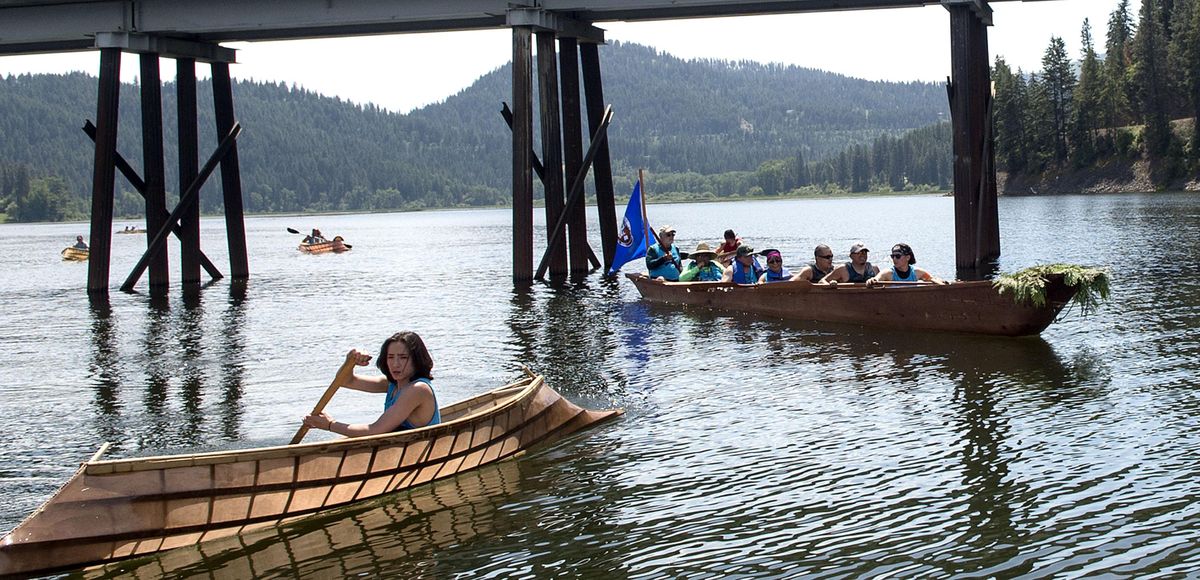Coeur d’Alene Tribe members begin 100-plus mile journey in dugout canoe

Smoke from burning sweetgrass drifted over the 35-foot-long dugout cedar canoe and its seven paddlers.
Words of prayer and blessing were spoken, seeking protection for the trip ahead.
And then the crowd erupted with cheers, whistles and back-slapping excitement as the paddlers took their places. Vincent Peone, a member of the Coeur d’Alene Tribe, slipped into the canoe’s last open seat and picked up his paddle. The shovel-nose canoe glided through the marshy waters at the southern end of Lake Coeur d’Alene, gaining speed as the paddlers found their rhythm.
Tuesday’s launch marked the beginning of a 100-plus-mile journey for the Coeur d’Alenes in the hand-carved canoe. Members of the tribe will paddle north on the lake that bears their name, before heading down the Spokane River and into the Columbia. They’ll meet four other Inland Northwest tribes on June 17 at Kettle Falls, an ancient fishing spot, for a summer solstice celebration and a salmon ceremony.
The trip was planned to call attention to the tribes’ interest in restoring salmon to the Columbia River above Grand Coulee Dam, which has blocked fish passage since the 1930s.
But for Peone, the journey really started last summer, when a 700-year-old western red cedar arrived on the Coeur d’Alene Indian Reservation. The 28,000-pound log was a gift from the Upper Columbia United Tribes, which purchased logs for its five member tribes to fashion into canoes for the trip to Kettle Falls.
Peone and his cousin, Jeff Jordan, spent hundreds of hours on the project. They helped schoolkids and elders use elbow adzes and other hand tools to carve the shovel-nose canoe – the first made by the tribe in recent memory.
Each fragrant cedar shaving helped connect tribal members to the time when canoes were “kings of the lake,” in the words of Felix Aripa, a 92-year-old tribal elder. Canoes were used for transportation, fishing and even for lulling fretful babies to sleep.
“Today we’re bringing back our canoes,” said Aripa, who spoke at the canoe blessing before the launch.
“This has been a long time coming,” an emotional Peone said. “It’s way overdue.”
He sat in the canoe’s second-to-last seat, with Jordan behind him. At the front of the canoe, cedar boughs filled an open seat, honoring the tribe’s ancestors. The Coeur d’Alene Tribe’s flag flew from the stern.
A drone hovered above the canoe, recording the action.
“Because this is such a grand historical re-awakening, we have a drone,” said Peone, chuckling.
The canoe moved easily through the water, an elegant but sturdy craft. The shovel-nosed canoe was one of several designs used by the Coeur d’Alene Tribe. It was the workhorse of the lake, with a function similar to a pickup truck.
Six smaller sturgeon-nosed canoes launched with the larger canoe, accompanying it up the lake. The lighter canoes were made of cedar and maple frames, covered with Kevlar. Some of the sturgeon-nosed canoes were made by families from the tribe, who entered a lottery for a chance to work with a master canoe builder.
Maria Bighead, her husband, Murle, and three generations of the couple’s extended family worked on that project.
“It’s a very historic event to bring the canoe back,” Maria Bighead said. “I want to be part of that, and I want my family to be part of that. It will bring us closer to our ancestors, who were out on the water.”
Fifteen-year-old Kodamen Matheson took off school on Tuesday to paddle a sturgeon-nosed canoe up the lake. He planned to do extra homework that night so he could get parental approval to be back on the lake Wednesday.
“He said, ‘Dad, you’re taking me tomorrow,’ ” said his father, Quanah Matheson.
Camp Larson, which is on the west side of the lake across from Harrison, was the tribal members’ destination for the first leg of the trip. They’ll resume the journey Wednesday, with plans to arrive at Coeur d’Alene’s City Beach in the late afternoon.
Two boats followed the canoes with relief paddlers, switching out the seven-member crew as people grew tired.
“Every ripple of the water and the scent of the lake brings us closer to our families,” said Charlotte Nilson, a Coeur d’Alene Tribal Council member.
Aching arms and shoulders also helped make the experience authentic.
“Paddling is hard work,” Peone acknowledged. “We’re the motors.”